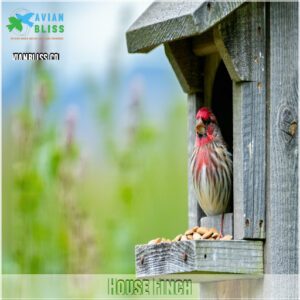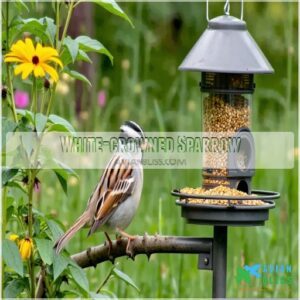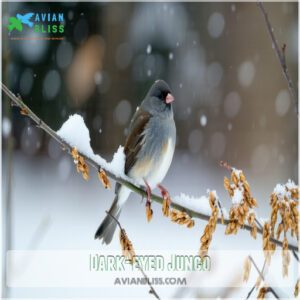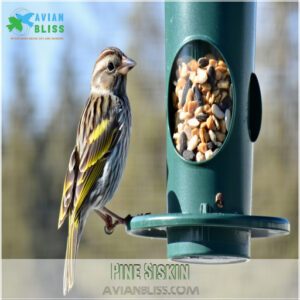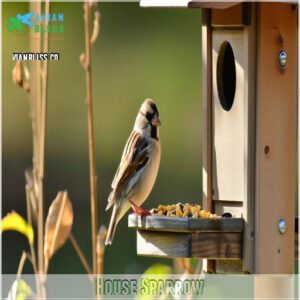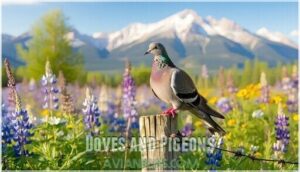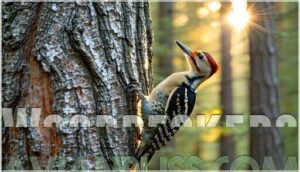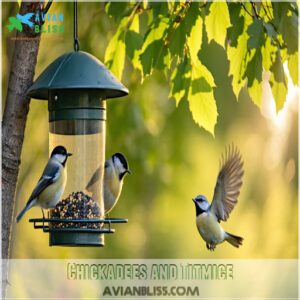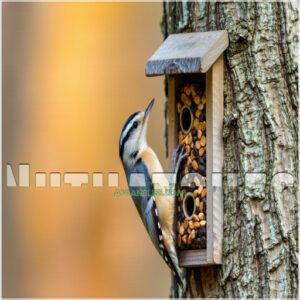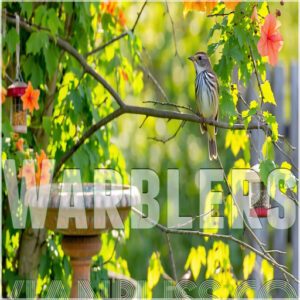This site is supported by our readers. We may earn a commission, at no cost to you, if you purchase through links.
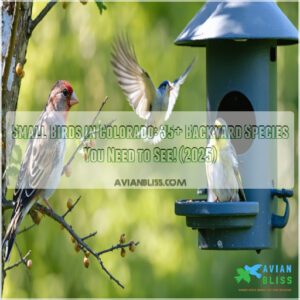
You’ll spot House Finches with their rosy-red heads and cheerful chirps, or the American Goldfinch, which glows bright yellow in summer.
Keep an eye out for the Dark-eyed Junco, a winter visitor with slate-gray feathers, or the bold Black-capped Chickadee, always full of energy.
Don’t miss the quirky White-breasted Nuthatch, famous for climbing trees upside-down!
Whether it’s sparrows, woodpeckers, or even tiny warblers, there’s always something to admire.
Stick around for tips on attracting these beauties to your yard!
Table Of Contents
- Key Takeaways
- Sparrows and Finches
- Doves and Pigeons
- Jays and Crows
- Woodpeckers
- Chickadees and Titmice
- Nuthatches
- Warblers
- Blackbirds and Orioles
- Attracting Small Birds to Your Yard
- Identifying Small Birds in Colorado
- Frequently Asked Questions (FAQs)
- What are the most common backyard birds in Colorado?
- What birds live in Denver?
- What is the smallest bird in Colorado?
- Where do Bluebirds live in Colorado?
- What does a Bluebird look like in Colorado?
- Do you see birds at feeders or backyards in Colorado?
- What are the most common birds in Colorado?
- How can I identify a bird in my yard?
- What is a grey bird that looks like a finch?
- What is the smallest bird of prey in Colorado?
- Conclusion
Key Takeaways
- Keep your feeders stocked with favorites like sunflower seeds, nyjer, and suet to attract finches, chickadees, and woodpeckers year-round.
- Add native plants and water sources like bird baths to create a welcoming habitat for American Goldfinches.
- Watch for distinct features like plumage, size, and behavior to identify birds like American Goldfinches, Dark-eyed Juncos, or Black-capped Chickadees.
- Enjoy seasonal highlights like bright goldfinches in summer or lively juncos during winter visits.
Sparrows and Finches
You’ll find Colorado’s sparrows and finches brightening up your backyard with their cheerful songs and colorful feathers, from the rosy-cheeked House Finch to the dapper Dark-eyed Junco.
These small but mighty songbirds will keep you entertained year-round as they flock to your feeders, especially if you’ve got a supply of their favorite treats like sunflower seeds and nyjer.
They are particularly attracted to feeders with nyjer, which provides them with the necessary nutrients to thrive throughout the year.
House Finch
Throughout Colorado’s neighborhoods, the charismatic House Finch brings a splash of color to your feeders.
Males sport a raspberry-red head and rosy breast, while females rock an elegant brown-streaked pattern.
These social backyard birds love sunflower seeds and are famous for their cheerful, warbling song.
You’ll spot them year-round, building cozy nests on ledges or in hanging plants, making them perfect subjects for beginner birdwatchers.
White-crowned Sparrow
While House Finches bring vibrant reds to your yard, the White-crowned Sparrow adds a touch of royal elegance with its distinctive black-and-white striped crown.
These medium-sized songbirds are a common sight in Colorado’s backyard bird havens.
- Feeding Habits: They’ll happily feast on millet, cracked corn, and sunflower seeds scattered on ground feeders
- Habitat Selection: Prefer brushy areas and open woodlands with plenty of cover
- Nesting Behavior: Build cup-shaped nests close to the ground in dense vegetation
- Migration Patterns: Some stay year-round, while others head south for winter
These dapper birds sport a gray breast, brown-streaked back, and that unmistakable striped head that makes bird identification a breeze! They are known for their distinctive black-and-white striped crown, and their common presence in backyard bird havens.
Dark-eyed Junco
Moving beyond white-crowned sparrows, you’ll love watching dark-eyed juncos hop around your yard in winter.
These small birds arrive in Colorado like clockwork each fall, their slate-gray backs and flashy white tail feathers catching your eye.
They’re social butterflies at ground feeders, darting about in cheerful flocks while making sweet trilling calls.
Look for them scratching through scattered millet and cracked corn with their pink-white bills.
American Goldfinch
Spotting an American Goldfinch in your Colorado backyard is like finding a flying ray of sunshine!
In winter, they sport olive-brown plumage, but summer transforms them into brilliant yellow jewels with black wings and caps.
These small birds are strict vegetarians, preferring:
- Nyjer seeds in special tube feeders (their absolute favorite!)
- Black oil sunflower kernels scattered on platform feeders
- Natural foods like dandelion and thistle seeds
Watch for their bouncy, wave-like flight pattern and listen for their sweet "po-ta-to-chip" call that brightens any day.
Pine Siskin
As fluttery and energetic as their goldfinch cousins, Pine Siskins bring a delightful mix of chirps and twittering to your Colorado yard.
You’ll spot these small, heavily streaked finches traveling in tight-knit winter flocks, often raiding your thistle and sunflower feeders.
During their nomadic bird migration, they’ll sweep through unexpectedly – nature’s little surprise visitors.
Look for their yellow wing patches and sharp, pointed bills.
House Sparrow
Ever noticed house sparrows—those plucky, city-loving birds?
They’re feisty urban birds, often claiming feeder spots with cracked corn or millet.
These cavity-nesters stick around year-round but may wander in winter.
Declining from habitat loss, they’re still one of the most common small birds in Colorado.
Add native plants to help them thrive while enjoying their lively sparrow behavior in your yard!
Doves and Pigeons
You’ll love spotting doves and pigeons in Colorado—they’re graceful, understated, and surprisingly fascinating.
From the gentle coos of Mourning Doves to the urban antics of Rock Pigeons, these birds bring charm to every corner of the state!
Mourning Dove
Mourning Doves: Gentle Ground Feeders
You’ll love how peaceful mourning doves are.
With soft brown feathers and black-spotted wings, they’re masters of blending in.
These backyard birds often feed on the ground, so use seeds in ground feeders to welcome them.
Their cooing calls feel nostalgic, like nature’s lullaby.
Watch out, though—they prefer quiet, serene spots away from noisy, rowdy birds!
Eurasian Collared-Dove
Eurasian Collared-Doves, larger than Mourning Doves, stand out with their buffy-brown plumage and a neat black collar.
They’re laid-back, not pushing others around at feeders. You’ll spot them in urban areas, perched near trees, cooing their three-part tune.
- Habitat: Urban spots with trees
- Diet: Ground seeds
- Flight Speed: Elegant, steady
- Nesting Behavior: High branches
Rock Pigeon
Bigger and bolder than most small birds, Rock Pigeons are the kings of urban skies.
These "feral birds" thrive in Colorado, scattering others at feeders with their confident antics. While they’re not part of bird migration patterns, they’re everywhere you look.
Watch for these traits:
- Stout bodies and varied plumage colors
- Urban birds, nesting on bridges and buildings
- Confidently cooing and flapping at feeders
- Aggressive pigeon behavior, chasing others
- A hearty pigeon diet of seeds and scraps.
Love ’em or not, they’re unforgettable!
Jays and Crows
If you’ve ever spotted a bold, flashy Steller’s Jay or heard the raspy call of an American Crow, you know these birds bring personality to your yard.
Jays and crows are intelligent, curious, and not shy about stealing snacks, so keep an eye on your picnic!
Steller’s Jay
Steller’s jays bring drama to your yard with their bold personalities and striking feather patterns—deep blue with dark-gray accents.
Their noisy bird calls, from screeches to melodic whistles, guarantee they’re never ignored.
These common small birds in Colorado often show off quirky foraging behavior, caching food for later.
Look out for fascinating courtship displays too—puffing, bowing, and plenty of flair!
Woodhouse’s Scrub-Jay
How do you spot a Woodhouse’s Scrub-Jay? Look for its bold blue feathers paired with a creamy breast.
These lively, clever birds dominate feeders and even mimic other birds!
Want them in your yard? Try these tips:
- Habitat Conservation: Plant native shrubs.
- Bird Behavior: Give space at feeders.
- Feather Patterns: Appreciate their beauty.
- Migration Routes: Watch them seasonally.
American Crow
Known for their bold "caw-caw," American Crows are geniuses in feathers!
These all-black, highly social birds thrive in Colorado, forming tight family groups.
Their sturdy stick nests are masterpieces of effort.
Although they’re non-migratory, crows might roam for food during snowy winters.
Their cleverness in solving problems will amaze you, making them unforgettable in the category of small birds Colorado offers!
Woodpeckers
Woodpeckers are some of the most fascinating birds you’ll spot in Colorado’s backyards, with their bold colors and tree-tapping antics.
From the tiny Downy Woodpecker to the striking Northern Flicker, these birds are like nature’s carpenters, always busy and impossible to ignore!
Northern Flicker
The Northern Flicker is one of the most striking small birds in Colorado, often spotted hopping on the ground, hunting ants and beetles.
Its brown plumage with black bars, flashes of red or yellow underwings, and a white rump patch make it easy to identify.
Want to attract these woodpeckers?
- Flicker Habitat: Keep leaf litter or wood chips around.
- Flicker Diet: Offer suet cakes.
- Woodpecker Behavior: Listen for their loud, rolling calls!
Downy Woodpecker
The Downy Woodpecker, one of the cutest small birds in Colorado, is a backyard favorite.
Its black-and-white feathers, plus the male’s red head patch, make it easy to spot. These tiny acrobats love suet, insects, and even sweet sips from hummingbird feeders.
Often confused with its larger cousin, the Hairy Woodpecker, the Downy can be distinguished by comparing beak sizes. Keep an ear out for their soft pecking patterns—it’s like nature’s gentle drumbeat!
| Feature | Details | Fun Fact |
|---|---|---|
| Size | 6-7 inches | Smallest woodpecker in Colorado |
| Plumage | Black and white | Males have a red patch on their head |
| Diet | Suet, insects, nectar | Will snack on hummingbird feeders |
| Habitat | Forests, woodlands | Common in backyard bird feeding spots |
| Behavior | Gentle pecking patterns | Often seen clinging to tree trunks |
Hairy Woodpecker
The Hairy Woodpecker is a striking bird you’ll enjoy watching.
It thrives in mature forests and woodlands, showcasing its woodpecker habitat.
Larger than the Downy, it’s easy to identify with:
- A long, sturdy bill perfect for pecking behavior.
- Crisp white outer tail feathers, free of black spots.
- A loud, sharp drumming sound echoing through the trees.
Chickadees and Titmice
You’ll love spotting chickadees and titmice—they’re tiny, energetic, and full of personality.
These acrobatic birds, like the Black-capped Chickadee and Mountain Chickadee, are year-round residents in Colorado, often found flitting through trees or visiting feeders for seeds.
Black-capped Chickadee
Spotting a Black-capped Chickadee feels like meeting nature’s tiny acrobat.
These small Colorado birds are just five inches long but full of charm! With their black cap, white cheeks, and gray back, they’re easy to identify.
Chickadee behavior is playful—they’ll hop around feeders, grabbing suet, seeds, or peanuts. Their famous “chick-a-dee-dee-dee” song is both a greeting and a warning.
Resilient even in winter, they stash food to survive. Watching them? It’s like having a cheerful guest in your yard!
Mountain Chickadee
The Mountain Chickadee is a lively, gray-backed bird with a bold white eyebrow, perfect for spotting in Colorado’s mountain habitat.
These sociable flocks brighten winter days at feeders with their cheerful "chick-a-dee" calls.
Attract them with sunflower seeds or suet.
Unlike their Black-capped cousins, they’re braver and love evergreen forests.
Who wouldn’t enjoy these charming, feathered acrobats?
Nuthatches
You’ll love spotting nuthatches in your Colorado backyard, especially their quirky upside-down antics on tree trunks.
These tiny climbers, like the Red-breasted and White-breasted Nuthatches, are year-round residents that adore suet and sunflower seeds.
Red-breasted Nuthatch
The Red-breasted Nuthatch is a fiery little acrobat you’ll love spotting.
With its black-and-white head, bluish-gray back, and rusty-orange belly, it’s a standout among small birds in Colorado.
These feisty visitors enjoy pine woodlands but adapt well to backyards.
- Offer suet and sunflower seeds.
- Provide nest boxes.
- Keep dead branches for nesting.
White-breasted Nuthatch
The White-breasted Nuthatch is a bold little acrobat you’ll love spotting in your yard.
These woodland birds, with their black cap, white face, and bluish-gray back, are easy to recognize.
They’re famous for their upside-down antics and feisty attitude, often chasing off other small birds.
To attract them, try suet, sunflower seeds, or peanuts in mesh or upside-down feeders.
Their Nuthatch behavior is pure entertainment—energetic, curious, and always on the move.
Who knew bird feeding could be this fun?
Warblers
Warblers are like nature’s confetti, adding bursts of color to your yard! The Yellow-rumped Warbler, a favorite among small birds in Colorado, is easy to spot with its bright yellow rump and flanks.
Colorado also boasts diverse quail species.
In winter, it’s dressed in muted tones:
- Brown crown
- White throat
- Black-streaked breast
- White wing bars
Come summer, their bird plumage shines with bold yellow faces and crowns. Love warbler songs? Offer suet, seed mixes, and water to welcome these lively travelers during warbler migration!
Blackbirds and Orioles
Blackbirds and orioles bring bold colors and lively songs to your yard, making them some of the most exciting small birds in Colorado.
The Red-winged Blackbird steals the show with its glossy black feathers and fiery red-and-yellow shoulder patches.
Males love to perch high, flashing their colors while singing their hearts out.
Females, though less flashy, charm with their streaked brown plumage.
Learn about various orange and black bird species.
The Bullock’s Oriole and Baltimore Oriole dazzle with bright orange feathers.
Their hanging nests are like nature’s art projects—intricate and fascinating!
- Fun facts:
- Orioles prefer oranges and jelly.
- Blackbird migration peaks in spring.
- Listen for unique bird song patterns!
Attracting Small Birds to Your Yard
If you want your yard to be a hotspot for Colorado’s cutest feathered visitors, it’s easier than you think!
With the right feeders, seeds, and a splash of water, you’ll have tiny birds flocking in no time.
Just don’t forget to grab your binoculars!
Provide a Variety of Feeders
Want to see your yard buzzing with life? Try mixing up Feeder Types! Tube feeders are perfect for finches, while suet feeders bring in woodpeckers. Ground feeders? Great for juncos and doves.
Attracting birds with native plants offers shelter.
Here’s a quick guide:
| Feeder Type | Best For | Seed Type | Placement | Fun Fact |
|---|---|---|---|---|
| Tube Feeder | Finches, Sparrows | Nyjer, Sunflower | Hang on a pole | Birds love perching here! |
| Suet Feeder | Woodpeckers, Chickadees | Suet Cakes | Near trees | Mess-free feeding! |
| Ground Feeder | Juncos, Towhees | Mixed Seeds | Flat surfaces | Watch for ground hoppers! |
| Hopper Feeder | Cardinals, Jays | Sunflower, Peanuts | Elevated posts | Holds more food! |
| Platform Feeder | Doves, Robins | Fruit, Seeds | Open spaces | Easy for larger birds! |
Mixing styles keeps backyard birds Colorado happy and coming back!
Offer a Diverse Selection of Seeds and Suet
Boost your backyard birdwatching by offering a buffet of seeds and suet! Birds love variety, and the right snacks keep them coming back.
Try these favorites:
- Black-oil sunflower seeds: Perfect for finches, sparrows, and more.
- Nyjer seeds: Goldfinches and siskins can’t resist them.
- Insect-packed suet cakes: A woodpecker’s dream meal!
Understanding the benefits of sunflower seed selection is essential for attracting various bird species.
Keep feeders clean and watch the magic happen!
Create a Bird-friendly Habitat With Native Plants
Transform your yard into a haven for small birds, Colorado-style! Choose native plants for seeds, berries, and nectar—they’re like a buffet for birds.
Add dead trees or brush piles for nesting and insect snacks.
Native plants thrive in local soil, conserving water and reducing maintenance.
A well-designed habitat means more chirps, fewer weeds, and endless bird-watching joy!
Provide a Reliable Water Source
Adding a reliable water source is a game-changer for attracting small birds in Colorado.
Bird baths, water features, or even rain barrels work wonders! Keep water fresh and clean—nobody likes a dirty drink, right? Place it near shrubs for safety but visible for easy access.
Birds love splashing around, so it’s like setting up a spa for your feathered friends.
When selecting a bird bath, consider the importance of a proper bird bath colorado design to attract various species.
Identifying Small Birds in Colorado
Spotting and identifying small birds in Colorado is like solving a fun nature puzzle! Keep a Colorado bird identification guide nearby to match features like bird size variations, feather patterns, and beak shapes.
Look for the black-capped chickadee with its bold black cap and white cheeks, or the mountain chickadee, rocking a stylish white eyebrow. Notice the white-breasted nuthatch climbing tree trunks with its gray back and white belly.
The downy woodpecker is tiny but flashy, with black-and-white feathers and a red nape, while the northern flicker sports spotted plumage and a cheerful call.
Listen for songs, study their nesting habits, and enjoy the thrill of spotting these feathered wonders!
Understanding local common birds habitats is essential for effective birdwatching in the region.
Frequently Asked Questions (FAQs)
What are the most common backyard birds in Colorado?
You’ll find common backyard birds in Colorado like the cheerful House Finch, chatty Black-capped Chickadee, flashy American Goldfinch, and curious Downy Woodpecker.
Keep feeders stocked with seeds, and you’ll enjoy their company!
What birds live in Denver?
Did you know Denver hosts over 500 bird species?
In your backyard, you’ll likely spot American Robins, House Finches, and Black-capped Chickadees year-round.
They’re like feathery neighbors, chirping away while you sip coffee!
What is the smallest bird in Colorado?
The tiniest bird in Colorado is the Calliope Hummingbird, measuring just 3 inches long.
It’s like a flying jewel, zipping around mountain meadows.
You’d almost think it’s a fairy with wings!
Where do Bluebirds live in Colorado?
Home sweet home for bluebirds in Colorado includes open woodlands, meadows, and grasslands.
They love nesting in tree cavities or nest boxes.
Keep an eye out in spring—they’re nature’s little bursts of happiness!
What does a Bluebird look like in Colorado?
Bluebirds in Colorado are stunning! They’ve bright blue backs, rusty orange chests, and white bellies.
Males are more vibrant, while females are softer in color.
Their cheerful look matches their sweet, melodic songs—pure backyard joy!
Do you see birds at feeders or backyards in Colorado?
Nearly 57% of winter bird checklists in Colorado mention Dark-eyed Juncos, and yes, you’ll spot plenty of birds at feeders!
From cheerful chickadees to bright goldfinches, backyard feeders are buzzing with feathered visitors.
What are the most common birds in Colorado?
The most common birds in Colorado include the American Robin, House Finch, Black-capped Chickadee, Mourning Dove, and European Starling.
You’ll often spot them in backyards, parks, or forests—always ready to brighten your day!
How can I identify a bird in my yard?
Don’t worry if birdwatching feels tricky!
Start by noting size, colors, and patterns. Watch its behavior—does it hop or glide?
Check its habitat too. Apps like eBird or Audubon make ID’ing fun and easy!
What is a grey bird that looks like a finch?
It’s likely a House Sparrow.
Males sport a gray crown and black bib, while females are brown with subtle streaks.
These urban adventurers love crumbs, seeds, and mischief.
Check their tan eye stripe for confirmation!
What is the smallest bird of prey in Colorado?
The smallest bird of prey in Colorado is the American Kestrel.
Weighing just 3-6 ounces, it’s a fierce little hunter, often spotted perched on wires, scanning for insects, mice, or small birds to snatch!
Conclusion
Exploring the small birds in Colorado is like opening a treasure chest of nature’s wonders!
From bright goldfinches to busy nuthatches climbing trees like acrobats, there’s always something to make you smile.
Add feeders with mixed seeds, suet, and water, and watch your yard turn into a bird paradise.
Remember, planting native shrubs helps too.
Take a moment to listen to their songs—you might just fall in love with their tiny yet fascinating world.
- https://coloradocollege.libguides.com/c.php?g=286973&p=1908228
- https://avianreport.com/backyard-feeder-birds-in-colorado-guide/
- https://www.uncovercolorado.com/common-native-birds-in-colorado/
- https://www.allaboutbirds.org/guide/Mourning_Dove/overview
- https://www.audubon.org/field-guide/bird/dark-eyed-junco

